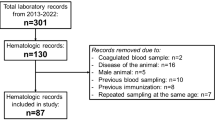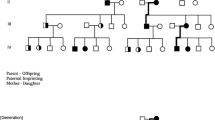Abstract
THE small South American primates of the Hapalidae family, the marmosets, are unique in that twin births are an almost consistent occurrence1. This twinning phenomenon further is unusual in that all twins appear to be fraternal, and placental vascular anastomoses result in haematopoietic chimerism of the young. Blood chimerism in adult male and female marmosets has been demonstrated by sex-chromosome analyses of cells in metaphase and also by examination of peripheral blood leucocytes for the drumstick-bearing neutrophils2,3. Sex-chromosome analysis of lymph node, spleen and bone marrow cells has also revealed chimerism: thus all haematopoietic tissues are involved3. Erythrocyte chimerism, although presumed to exist, has not yet been demonstrated owing to the unavailability of blood-grouping reagents in this species. Although previous investigations have indicated the presence of human A- and B-like antigens on the marmoset red cells, differences among marmosets of these human blood group substances are not apparent4–6. Tests for naturally occurring isohaemagglutinins in these animals have thus far been negative. The natural blood chimerism assumed to exist in all marmosets because of the twinning phenomenon would appear to preclude or make exceedingly difficult successful red cell isoimmunizations since both donor and recipient could conceivably have two (or more) major genetically distinct blood-group antigens. In a random-bred colony without any breeding records, therefore, the prior knowledge of chimerism in any one animal (as determined by sex-chromosome analysis) could be of considerable value. Thus, if on the basis of sex-chromosome analysis one could find an animal that is definitely a heterosexual chimera, yet in only a small proportion (10–20 per cent), its red cells would be more desirable for immunization purposes in making specific reagents than those of an animal with a relatively high degree of chimerism, or one in which the degree of chimerism is not known. This procedure would have merit only if the degree of chimerism as determined by sex-chromosome analysis of dividing white cells is also representative of the chimerism of the erythropoietic system, an assumption that must be made until evidence shows otherwise. In an analysis of the dividing white cells of the peripheral blood of twenty-six marmosets found to be heterosexual chimeras, two male animals had 12 per cent (No. 21-11-5) and 18 per cent (No. 21-1-1) chimerism of female cells, the lowest observed in our colony. These were then used as red-cell donors for isoimmunizations.
This is a preview of subscription content, access via your institution
Access options
Subscribe to this journal
Receive 51 print issues and online access
$199.00 per year
only $3.90 per issue
Buy this article
- Purchase on Springer Link
- Instant access to full article PDF
Prices may be subject to local taxes which are calculated during checkout
Similar content being viewed by others
References
Wislocki, G. B., Amer. J. Anat., 64 445 (1939).
Benirschke, K., and Brownhill, L. E., Cytogenetics, 1, 245 (1962).
Gengozian, N., Batson, J. S., and Eide, P., Cytogenetics, 3, 384 (1964).
Gengozian, N., Proc. Soc. Exp. Biol. Med., 117, 858 (1964).
Weiner, A. S., Moor-Jankowski, J., and Gordon, E. B., Amer. J. Phys. Anthropol., 22, 175 (1964).
Merritt, C. B., and Hampton, J. K., Fed. Proc., 24, 631 (1965).
Gengozian, N., Batson, J. S., and Smith, T. A., in Proc. Intern. Symp. Bone Marrow Therapy and Chemical Protection in Irradiated Primates, August 15–18, 1962, 245–9 (Radiobiological Institute, the Netherlands, 1962).
Author information
Authors and Affiliations
Rights and permissions
About this article
Cite this article
GENGOZIAN, N. Formation of Isohaemagglutinins in the Marmoset, Tamarinus nigricollis. Nature 209, 722–723 (1966). https://doi.org/10.1038/209722a0
Issue Date:
DOI: https://doi.org/10.1038/209722a0
Comments
By submitting a comment you agree to abide by our Terms and Community Guidelines. If you find something abusive or that does not comply with our terms or guidelines please flag it as inappropriate.



